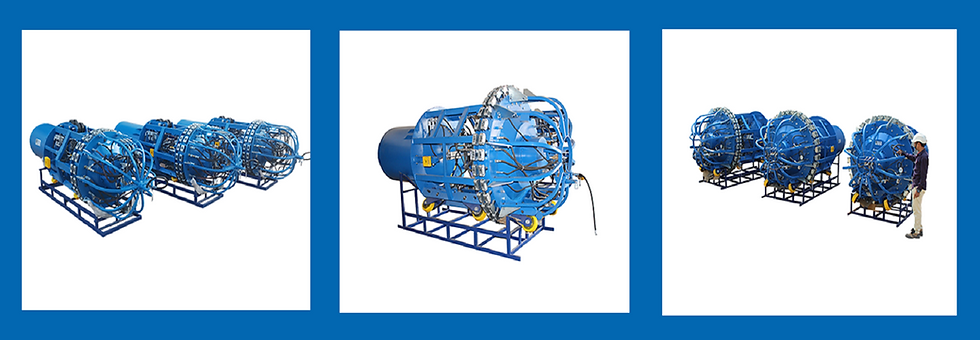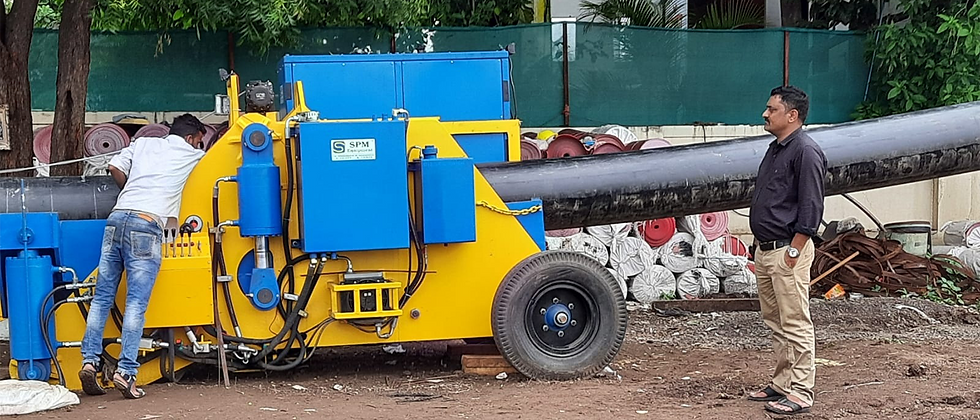How to Choose the Right Equipment for Your Cross Country Pipeline Project
- infospmequipment
- Feb 14, 2024
- 5 min read

Cross-country pipeline projects require careful planning and the use of specialized equipment to ensure efficient and successful completion. As the largest cross-country pipeline equipment manufacturer and supplier in multiple countries around the world, we understand the importance of selecting the right equipment for your project. In this article, we will guide you through the process of choosing the right cross-country pipeline equipment, ensuring that your project is completed smoothly and effectively.
The advantages and features of Cross Country Pipeline Equipment (CPE) can vary depending on the specific type of equipment you're referring to. However, here's a general overview:
General Advantages:
Durability and Reliability: Designed to withstand harsh environments and demanding conditions, often in remote locations.
Efficiency and Productivity: Optimize pipeline construction, operation, and maintenance processes, saving time and cost.
Safety and Security: Incorporate safety features to minimize risks and protect workers and the environment.
Modular and Portable: Many equipment types are designed for easy transport and assembly, facilitating deployment in diverse terrains.
Technology integration: Advancements like automation and remote monitoring enhance efficiency, safety, and data-driven decision making.
Specific Features (by equipment category):
Pipe Handling:

Bending machines: Precisely bend pipes for various angles and configurations.
Welding machines: Create strong and reliable welds for pipe connections.
Coating equipment: Apply protective coatings to pipes for corrosion resistance and longevity.
Transportation equipment: Specialized vehicles and trailers for efficient pipe movement over long distances.
Construction and Maintenance:
Trenching equipment: Excavates trenches for pipe installation with minimal environmental impact.
Lowering and stringing equipment: Safely and efficiently positions pipes into the trench.
Inspection and testing equipment: Ensures pipeline integrity and identifies potential issues before they occur.
Repair and rehabilitation equipment: Address pipeline defects and extend service life.
Operation and Monitoring:
Pumping and compression stations: Maintain product flow throughout the pipeline system.
Leak detection and monitoring systems: Proactively identify and address leaks for safety and environmental protection.
Telemetry and SCADA systems: Collect and analyze pipeline data for real-time monitoring and control.
Remote operation technologies: Enable efficient pipeline management from central locations.
Additional factors to consider:
Specific application: Equipment features and advantages will vary depending on the type of product being transported (oil, gas, water, etc.) and the pipeline environment (terrain, climate, etc.).
Manufacturer and model: Different manufacturers and models offer unique features and benefits. Researching specific options is crucial for informed decision-making.
Sustainability: Increasingly, environmentally friendly equipment features are gaining importance, such as fuel-efficient engines and reduced emissions technologies.
1. Assess Your Project Requirements:
Before diving into the selection process, it is crucial to assess your project requirements thoroughly. Consider the pipeline size, length, material, pressure, and environmental conditions. These factors will help you determine the specific equipment you need. For instance, if you are dealing with a large pipeline project with a high-pressure requirement, you will need heavy-duty pipeline roller equipment capable of withstanding the demands.
2. Research and Identify Trusted Manufacturers:
With the global market offering a wide range of cross-country pipeline equipment, it is essential to research and identify trusted manufacturers. Look for companies with a solid reputation in the industry, such as ours, which supplies equipment to major countries like Russia, USA, UAE, Australia, Malaysia, Mexico, Germany, Saudi Arabia, Singapore, Egypt, and Turkey. Consider factors such as the manufacturer's experience, quality certifications, customer reviews, and after-sales support.
3. Determine Equipment Compatibility:
Ensure that the equipment you choose is compatible with the specific requirements of your project. Check if the manufacturer offers customization options to tailor the equipment to your unique needs. It is also advisable to consult with experts who can guide you in selecting the most suitable equipment for your pipeline project.
4. Consider Equipment Efficiency and Safety Features:
Efficiency and safety are paramount in any pipeline project. Look for equipment that is designed to maximize productivity while complying with safety standards. Features such as advanced control systems, automatic shutdown mechanisms, and enhanced operator safety measures can significantly contribute to project success and minimize accidents.
5. Evaluate Equipment Maintenance and Service Support:
Proper maintenance and service support are crucial for ensuring the longevity and optimal performance of your equipment. When choosing a cross-country pipeline equipment supplier, inquire about their maintenance programs, availability of spare parts, and on-site service support. This will help avoid delays and disruptions during your project.
6. Compare Prices and Financial Considerations:
While price should not be the sole determining factor, it is crucial to compare prices among different manufacturers. Consider the overall value and return on investment (ROI) that the equipment can provide. Opting for high-quality equipment that may have a higher initial cost can save you money in the long run by minimizing downtime and repair expenses.
7. Seek Expert Advice:
It is always beneficial to seek expert advice when making important decisions regarding cross-country pipeline equipment. Collaborate with experienced professionals who can provide insights and recommendations based on their industry knowledge and expertise.
What is a Cross-Country Pipeline?

A cross-country pipeline Construction Equipment is a long-distance network of pipes used to transport liquids or gases over significant distances, typically between cities, countries, or even continents. These pipelines are often constructed from steel and can range in diameter from a few inches to several feet.
We are largest Cross Country Pipeline Equipment Manufacturer and supplier in Russia, USA, UAE, Australia, Malaysia, Mexico, Germany, Saudi Arabia, Singapore, Egypt, Turkey.
They play a crucial role in transporting various substances, including:
Crude oil
Natural gas
Refined petroleum products
Water
Chemicals
Think of them as underground highways for energy and resources, enabling efficient and cost-effective movement compared to alternatives like trucks, trains, or ships.
Here's a breakdown of the key characteristics and components of a cross-country pipeline:
Components:
Pipes: Made of durable materials like steel, they form the backbone of the pipeline network.
Pumps and compressors: These are used to keep the liquids or gases flowing through the pipeline, especially over long distances and uphill sections.
Valves: Control the flow of the product within the pipeline and can be used to isolate sections for maintenance or safety purposes.
Tanks: Used for storage and to regulate pressure within the pipeline system.
Filters: Remove impurities from the product to prevent damage to the pipeline and ensure product quality.
Meters: Measure the flow and volume of the product being transported.
Monitoring and control systems: Continuously monitor pipeline conditions and product flow, allowing for real-time adjustments and ensuring safe operation.
Benefits:
Cost-effective: Compared to other transportation methods, pipelines offer lower overall costs per unit of product transported, especially for large volumes over long distances.
Efficient: Pipelines can move large volumes of product quickly and continuously, making them ideal for high-demand energy resources.
Environmentally friendly: Pipelines have lower greenhouse gas emissions and environmental impact compared to some other transportation methods, as they require less energy to operate and have a lower risk of spills.
Reliable: Pipelines are generally buried underground, providing protection from extreme weather and vandalism, offering a reliable mode of transportation.
Considerations:
Safety: Pipeline safety is a major concern, and stringent regulations and procedures are in place to prevent leaks, spills, and accidents.
Environmental impact: While generally considered more eco-friendly than other options, pipeline construction and operation can still have environmental impacts, and careful planning and mitigation measures are crucial.
Social impact: Pipeline projects can sometimes disrupt communities and land use, requiring careful consideration of social and cultural factors.
Overall, cross-country pipelines are a vital component of modern infrastructure, playing a key role in transporting energy and resources efficiently and cost-effectively. However, it's important to consider the potential safety, environmental, and social impacts associated with these projects.
In conclusion, choosing the right cross-country pipeline equipment for your project is crucial for its successful completion. Consider project requirements, research and identify trusted manufacturers, ensure equipment compatibility, evaluate efficiency and safety features, assess maintenance and service support, compare prices, and seek expert advice.
By following these guidelines and partnering with a reliable supplier, you can confidently select the right equipment and complete your cross-country pipeline project efficiently and effectively.
Check out our pipeline construction equipment lineup today. You can also call us at 1-800-RENT-CAT or contact us online for more information and a fast quote.



Comments